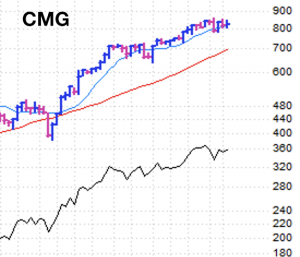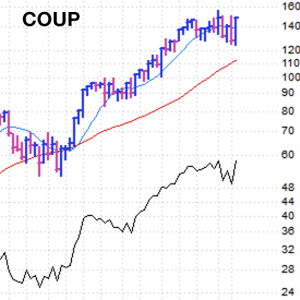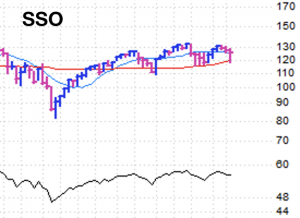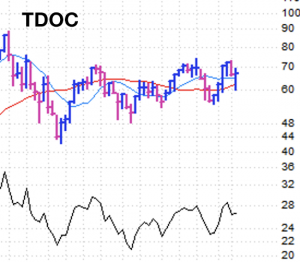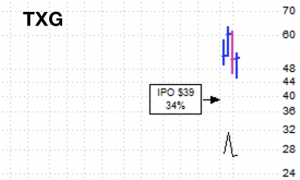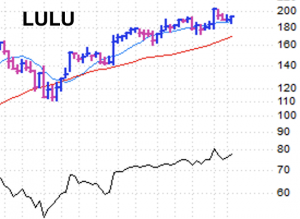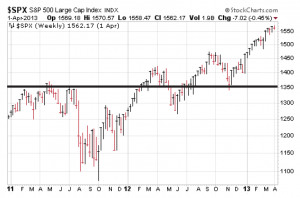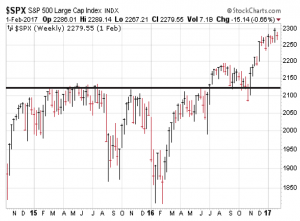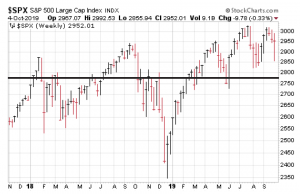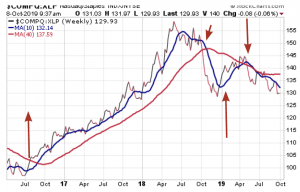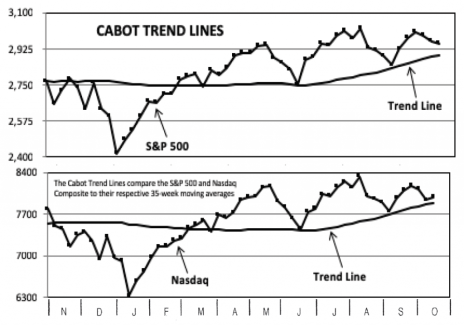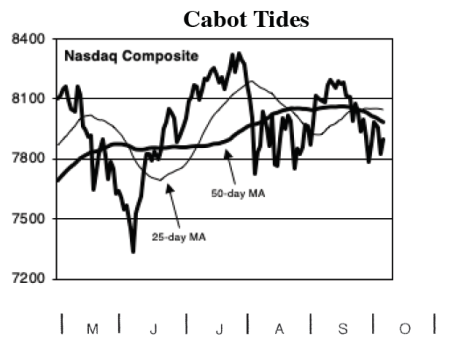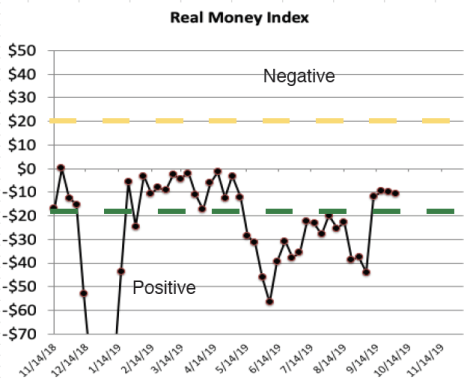The market remains all over the place, with news- and rumor-driven action pushing the indexes and individual stocks around every day. Our biggest thought remains that, while there’s plenty of evidence that tells us the next major move is probably up, the current environment remains extremely choppy with few stocks hitting new highs and little real money being made. Thus, we remain cautious, holding plenty of cash and going slow on the buy side—although we’re always keeping our eyes open for a sustained turn higher. In the Model Portfolio, we’re a bit more than half in cash and are building our watch list for the next advance.
Cabot Growth Investor 1430
[premium_html_toc post_id="188402"]
Patience Precedes Profits
We regularly write about practicing patience with your winning stocks, and that will always be a key factor in making big money—unless you’re a savant, you’ll find that many of your trades will offset over time (small losses, break-evens, small wins, etc.), with the real money coming from your bigger winners.
But there’s another way that patience helps your portfolio, and that’s before you click the buy button—in waiting for the right pitch, so to speak, and making sure the environment is ripe for higher prices before getting too far into the market’s waters. Indeed, even Jesse Livermore wrote in his book How to Trade in Stocks that patience precedes profits, as all those traders who feel they must be active every day are the ones that produce the setups in new leaders before they take off.
That’s our main thought today. Recently, the market environment has been a meat grinder—our Cabot Tides plunged back into negative territory last week, but really, the trend is mostly sideways and choppy, with the major indexes making no net progress for the past five to seven months, next-to-no individual stocks hitting new highs and vicious moves nearly every day (even intraday and overnight!) based on whatever is hitting the headlines.
If you’re a skilled day or swing trader, by all means go ahead and get your fill. But position (intermediate- to longer-term) investors like us look for more durable trends, which is where the big money is made. And with stocks ping-ponging every day or two, we’re content to patiently wait for the bulls to retake control.
It’s important to note that just because we’re playing defense now doesn’t mean we’re spouting doom and gloom. In fact, we still think the next major move is likely to be up—sentiment has been in the gutter for weeks, so most weak hands are likely already on the sideline, and we’re starting to see some washed-out breadth readings. Throw in the positive Cabot Trend Lines and the bullish longer-term studies from earlier this year and it’s important to remember the market could surprise on the upside if any good news (remember that?) comes around.
[highlight_box]WHAT TO DO NOW: Until then, though, it seems like the more money you invest, the less you end up with. Thus, you should lay low and keep your eyes open for a change in the market’s character. In the Model Portfolio, we’ve sold Blackstone and Teladoc since the last issue and are sitting with a 54% cash position while we continue to hone our watch list.
[/highlight_box]
Model Portfolio Update
It remains a meat grinder-type of environment, so we’re mostly laying low—the sale of CVNA in our last issue brought our cash position up to 39%, and two sells since then (BX and TDOC) have pushed that up to 54%.
From here, we’re really just going to play it by the book—if the market and individual stocks implode and our Cabot Trend Lines turn bearish, then we’ll likely turn outright defensive (70%-plus cash), but if things continue to chop around, we’re happy to give our current stocks a chance to continue holding up.
And we’re not forgetting about the upside, either. We still think there’s a solid chance we’re in the midst of the third and final leg of this rolling five-month market correction, and that the best stocks (including a few we already own) may have already hit their lows. Thus, should we see an October bottom, we’ll be ready—but as we’ve been writing, it’s all dependent on the bulls showing up and taking control.
Current Recommendations
SOLD—Blackstone (BX)—Blackstone isn’t a great down market stock, and when you throw in persistent rumors of capital controls (restricting investment in Chinese firms in one form or another), it’s been enough to crack the uptrend in its stock (as well as its private equity peers). The correction to this point hasn’t been awful (18%), so if BX could round out a new launching pad in the weeks ahead, we could revisit it once the market turns positive. But that’s a big if, and besides, our rule of not letting a decent profit turn into a loss triggered, prompting us to get out a couple of points above breakeven last week.
HOLD—Chipotle Mexican Grill (CMG 828)—CMG has been mostly quiet on the news front since announcing the nationwide launch of its latest menu addition (Carne Asada), but that hasn’t stopped the stock from whipping around wildly. In the near term, the stock has been rejected by the 850 area three times since the start of September, so that will probably be a tough nut to crack. And on the downside, we’re not ruling out a leg lower should the market stay weak and the sellers come around for some names that have held up well. But bigger picture, we still think Chipotle is in the middle innings of its turnaround both fundamentally (remember that sales-per-square-foot at its locations are still 20% below the company’s peak despite the huge growth in its digital business) and stock-wise (CMG’s original breakout following its bottom came in January of this year). That doesn’t guarantee success, but the odds still favor CMG having another leg up after its current consolidation. Having already taken some chips off the table, we’re content to sit tight and give the stock room to breathe.
HOLD—Coupa Software (COUP 154)—COUP has also been a wild child, gyrating between the upper 120s and low 150s a few times since early September, including coming very close to our stop at the end of last month. But the action in recent days has been very encouraging, with a big-volume ramp that has brought the stock to the verge of new all-time highs! There’s been nothing new from the company or analysts in recent weeks, but everything here points toward Coupa being an emerging blue chip in the business world—possibly the next Salesforce.com-type of company, with its business spend management platform becoming the gold standard for big and mid-sized companies as they look to gain insight and better control over their spending decisions. Having suffered a couple of jarring shakeouts while its sector peers have fallen apart, we’re optimistic the stock’s next major move is up—but as always, we’ll play things by the book, keeping a mental stop in the mid-to-upper 120s (above our cost basis of 123) in case the market gives up the ghost and the sellers really take control.
BUY A HALF—DocuSign (DOCU 67)—DOCU is acting like it wants to be one of (if not the) leading stocks of the next advance, and we say that not just because of its excellent recent action (it’s lifted to new recovery peaks on good volume this week) but also due to the overall evidence—whether it’s the 14-month post-IPO base (big winners often have to work through a year of sluggish, choppy action after coming public before getting going), the three straight big-volume weekly gains after earnings, the rapid, reliable and easy-to-understand growth story (e-signatures) and the big increase in institutional ownership (550-ish funds own shares, nearly double that of a year ago). Of course, there is some competition, including from giant Adobe, and in a weak market we’ll never rule out a sudden air pocket. But the longer DOCU actswell during this market downturn, the greater the odds it heads nicely higher once the bulls take control of the market. We’re OK buying a little here or (preferably) on dips of a couple of points if you don’t own any.
HOLD—Inphi (IPHI 62)—Usually when growth stocks are weak, semiconductor names are leading the way down, but this time around the situation has been reversed; most chip stocks have been holding firm and even advancing in recent weeks. Our favorite is Inphi, which isn’t just a sector play—the firm is the leading provider of high-speed data interconnects, which not only is a great longer-term growth area, but is beginning to see accelerating growth despite the ban on Huawei due to demand for long-haul, metro and 5G (which should ramp in a big way next year) from telcos and from cloud operators that are upgrading their systems. One thing we haven’t written about much is the acquisition of Acacia (an optical networking leader) by Cisco, which some feared would hurt business when announced, but management is on record saying they see only good things from the tie-up (both firms are Inphi customers). As for the stock, IPHI is in the midst of a reasonable eight-week, 15% deep consolidation following its heady prior run. We’re not against nibbling here if you don’t own any, but officially we’ll just stay on Hold.
HOLD—ProShares Ultra S&P 500 Fund (SSO 125)—It’s now been nearly five and a half months of ups and downs for the S&P 500, with trade war hiccups causing the first two dips (a 7.6% retreat in May and a 6.8% whoosh in August) and the recent spate of uncertainties (trade, impeachment, capital controls, recession fears) causing the latest 5.5% slide. Given the still-positive Cabot Trend Lines and the spate of blastoff indicators earlier this year, though, the odds favor the next big move being up. Plus, we do think this third pullback could be the “throw in the towel” event, not just for the past five months but for the market’s long consolidation that dates back to January 2018. (See page 6 for more on that.) Even so, today the intermediate-term trend is at best sideways, and until we see some real buying power emerge, we’ll stay on Hold. On the downside, a drop below the August lows (115 or so for SSO), which would likely coincide with a red light from the Cabot Trend Lines, will almost surely have us paring back.
HOLD—Snap (SNAP 14)—SNAP is currently the black sheep of the portfolio, as the stock has slid sharply before and after Facebook announced the release of its camera-based messaging app named Threads. Do we think this new offering will materially affect Snap’s results? No, and if we had a good-sized profit, we’d probably let the stock wiggle around, giving it a chance to continue its major turnaround. (Indeed, one analyst upgraded the stock after the Facebook news was released, saying he sees more good news on user growth thanks to new product development.) However, we have a loss, so while we’re hoping to hold through the upcoming quarterly report (due on October 22), we’re also keeping our position on the tightest of leashes—if SNAP can catch a bid,, we think it can rebound in a big way, but if the sellers do much more damage, we’ll be forced to cut our loss. Hold for now.
SOLD—Teladoc (TDOC)—We got kicked out of our half position in TDOC last week, but if you happen to still own some, we’d probably hang on—reports have come out that the Amazon in-house telehealth program, which brought out some sellers two weeks ago, is actually powered by Teladoc. And while the company isn’t being used by United Healthcare for its Medicare Advantage program, (a) one analyst thinks it could capture some of that opportunity down the road and (b) in either case, it has no effect on the major deal inked with United in September that should bring Teladoc millions of new subscribers. None of this means the stock is a buy right here—even after a decent bounce, it’s still stuck in the middle of a range it’s been trapped in since February. But while our timing was off on our initial buy, which forced us to cut our loss, we’re keeping an eye on TDOC to see if it can set up properly should the market return to health.
Watch List
Insulet (PODD 155): Medical device stocks are often tricky, but Insulet has shown no desire to stay down during the market’s wobbles and its Omnipod insulin pump has huge potential as diabetics switch from daily injections (PODD has just 5% to 6% of the Type 1 diabetes market in the U.S.) Earnings are due out November 5.
MasTec (MTZ 65): MTZ is four weeks into a consolidation after breaking out from an 18-month rest. Earnings are likely out in early November.
Pinduoduo (PDD 32): If the U.S.-China trade talks go sideways, maybe PDD breaks down. But so far, it’s done a reasonable job of shaking out some weak hands during the past month, and as a leader in the newer “social commerce” field, we see rapid growth for a long time to come.
RingCentral (RNG 174): RNG has had a big run, but a game-changing partnership last week could help growth accelerate further. The stock is super strong. See below.
Shake Shack (SHAK 93): SHAK is now five weeks into a correction that has taken it just below its 50-day line. More time may be needed, but everything we see in the chart and the story suggest the next major move is up.
Other Stocks of Interest
The stocks below may not be followed in Cabot Growth Investor on a regular basis. They’re intended to present you with ideas for additional investment beyond the Model Portfolio. For our current ratings on these stocks, see Updates on Other Stocks of Interest on the subscriber website or email mike@cabotwealth.com.
RingCentral (RNG 174)—The days of every employee heading into the office and sitting at their desk for eight hours are long gone, but the vast majority of communications systems used by companies (including most large enterprises) remain built to do just that. RingCentral is a leader in a newer field dubbed Unified Communications as a Service (UCaaS), which integrates voice, video, messaging and contact center solutions onto one platform, allowing workers to communicate via a variety of devices from anywhere. The company sees it as a whopping $50 billion opportunity, and it’s made steady progress penetrating the field, with sales growth of between 30% to 37% in each of the past 10 quarters (recurring revenue is huge here), helping the stock to have a huge run during the past year or two. But now the story just got even better—in exchange for a $500 million investment, Ring has become the exclusive provider of UCaaS solutions to Avaya, which has 100 million current communications users and serves 90% of the Fortune 500. By comparison, Ring has just a few million current users, so capturing just 3% to 5% of Avaya’s legacy user base would balloon the top and bottom lines. Not surprisingly, RNG has gone ballistic on the news—it sort of reminds us of the deal Exact Sciences inked with Pfizer late last year, which has led to accelerating growth and (until the recent growth stock selloff) a solid advance in the stock. Translation: The company, which was already set up nicely for continued 30%-ish growth, has just dramatically boosted its upside potential for the years ahead in a big way, and there’s no denying the recent buying power. RNG is on our Watch List.
10x Genomics (TXG 48)—Now here’s a new company with a very big idea. To this point, scientists have developed methods to relatively quickly, easily and cost effectively measure genomes and cells—but these are mostly “bulk” methods of analysis that average data across all the cells in a sample. But now 10x Genomics has come up with a better mousetrap—its Chromium instrument is able to look at things on a cell-by-cell level in a timely and cost efficient way, and because of that researchers have been buying the $55,000 system (which usually uses $140,000 of consumables annually—recurring income!) in droves, with 13 of the top 15 pharmaceutical companies and 93 of the top 100 global research institutions using it. To be fair, there is some risk here; while 10x is the leader in the field, there is some competition, and the firm is also fighting a lingering battle with Bio-Rad Labs in court (patent claims). But we’re OK with that because TXG is too new and thin for us right this second anyway—having just come public in the middle of September, the stock has chopped up and down during the past few weeks, which isn’t bad action given the market. Overall, TXG is a name we have on our “back burner” watch list—we’ll keep a distant eye on the stock, as some more seasoning and any good news on the legal front could produce a durable uptrend.
Lululemon (LULU 198)—Lululemon isn’t the young pup it was a few years ago, and its breakout this year (in March) has done just OK, leading to a couple of marginal new highs and plenty of choppy trading. But we still think this institutional favorite can do very well during a sustained uptrend for two reasons. First, fundamentally, not only is the company firing on all cylinders (sales up 20% or more six straight quarters, with earnings growing faster than sales every quarter), but excellent growth should continue thanks to the firm’s expansion into other lines of business—so-called athleisure wear is still big, but Lululemon has also moved into men’s wear (comparable sales up 27% in Q2!), office and commuting wear for ladies and even selfcare products like deodorant and moisturizer, not to mention a bigger push internationally and online (digital sales rose 31% in Q2 and make up one-quarter of sales). As for the stock, it’s reacted well to earnings multiple times this year, yet has also had three tedious, multi-week pullbacks of 10% to 12% during the past few months, with the latest dip finding support near the top of its prior base. It’s always possible the stock will get yanked down should the market stay weak, but we think LULU has the makings of a steady, strong leader of the next advance.
Big Consolidations Aren’t Unusual Since the Crisis
How often have you read that stocks have been in a never-ending bull market since the end of the global financial crisis in 2009? Don’t get us wrong, it’s been a great decade for stocks in general, but the pattern has been relatively stair-step in nature—the major indexes have rallied strongly for two to three years, followed by 18 to 24 months of ups and downs, with no net progress.
The first big rest period came in 2011-2012, following the huge off-the-bottom rally the prior two years. You can see that after hitting 1,350, the S&P 500 got hit hard in late 2011, and while they rallied to new highs a couple of times in 2012, the index ended up falling back to that 1,350 level in November of that year—21 months of no net progress. When the breakout came in 2013, it ushered in a huge, persistent advance for the next couple of years.
The next big rest began in early 2015, when the S&P 500 chopped around endlessly just north of 2,100. Again, after a couple of sharp dips later that year, the index reached to new highs in 2016, but a late-year pullback (just before the Presidential election of that year) brought it back to 2,100—another long (22 months) period of no progress. Once more, the breakout from that range in November 2016 led to a giant run.
Which brings us to today, or more accurately, the past 20 months—after the S&P 500’s spike peak in January 2018 to a bit over 2,850, the market had two big dips last year (especially the late-year implosion) and, after hitting new highs this year, has pulled back to that same 2,850 area … the same pattern that played out twice before in the prior two scenarios.
What’s the point? Two things. First, the fact that the market has already been doing nothing for 20 months (along with other factors like persistently negative sentiment) is a big reason why we think a sustained downtrend from here is less likely than the other two possibilities (more chop, or a sustained uptrend). And second, as a result of that, any decisive upside breakout that comes is likely to bring a solid, sustained upmove.
You probably know what we’ll say now: In no way are we predicting what comes next and when it will come. As we’ve written elsewhere in this issue, the onus is on the buyers to show up for more than a day or two. Until then, we’re cautious.
But oftentimes, stepping back from the day-to-day gyrations can provide some added perspective. And after a long sideways phase that looks a lot like the prior two post-2009 consolidations, it’s good to keep in mind the chance of the upside possibilities if the bulls take control.
An Indicator to Watch for the Next Growth Stock Ramp
We like to keep an eye on a couple of measures that look at the performance of growth-oriented stocks (like, say, the Nasdaq) versus defensive stocks (such as the consumer staples fund, symbol XLP); they aren’t precise timing tools but they do a nice job of letting us know whether big investors are aggressive or stepping lightly.
The chart here shows the ratio of the Nasdaq to XLP, along with that ratio’s 10-week and 40-week moving averages, and we like to look at it similarly to the Cabot Tides—if the ratio is above its lower, rising moving average, that’s usually a bullish environment for growth stocks; whereas otherwise, defensive stocks are generally garnering an outsized share of fund flows.
You can see that the index turned positive in mid-2016 (right after the initial Brexit vote) and stayed bullish right through early October of last year, which turned out to be a prescient sell signal. The next green light occurred the second week of January, with a breakdown occurring in early May. And defensive stocks have been outperforming ever since.
To be clear, we’re not going to trade just based on this indicator, but we write about it today as something to monitor: If the ratio can get above its 10-week line and that moving average turns up, it would be telling us the market’s five-month choppy environment is likely behind us and growth stocks are kicking into gear. We’ll be watching.
Cabot Market Timing Indicators
The market itself remains in solid shape, with the trends still pointed up (despite this week’s dip) and some money finally beginning to come in off the sideline. But growth stocks remain on the outs, which tells us to go slow on the buy side and honor our stops.
Cabot Trend Lines: Bullish
Our Cabot Trend Lines remain bullish, but they bear watching. Both the S&P 500 and Nasdaq dipped below their respective 35-week lines early last week before closing above them (by 2% for the S&P, by 1.3% for the Nasdaq) by Friday’s close … but both are now testing their respective trend lines again this week. A sell signal, remember, only comes when both indexes close two straight weeks below their 35-week lines, so the longer-term trend remains positive. But the next few trading days will be key.
Cabot Tides: Bearish
Our Cabot Tides are currently negative, but if we don’t leave our brains at the door, the intermediate-term trend is effectively sideways—the major indexes we track (including the Nasdaq Composite, daily chart shown here) have all been chopping sideways for the past five to seven months. With little money being made, it’s a good reason to pick your spots and hold plenty of cash.
Cabot Real Money Index: Neutral
Money continues to flow out of equity funds and ETFs, though in recent weeks, it’s been more of a trickle than a roar. And that keeps our Real Money Index in neutral territory for the short-term. That said, should the market continue to chop around, it will be interesting to see if investors truly throw in the towel by stampeding out of stocks and into cash.
The next Cabot Growth Investor issue will be published on October 24, 2019.
Cabot Wealth Network
Publishing independent investment advice since 1970.
CEO & Chief Investment Strategist: Timothy Lutts
President & Publisher: Ed Coburn
176 North Street, PO Box 2049, Salem, MA 01970 USA
800-326-8826 | support@cabotwealth.com | CabotWealth.com
Copyright © 2019. All rights reserved. Copying or electronic transmission of this information is a violation of copyright law. For the protection of our subscribers, copyright violations will result in immediate termination of all subscriptions without refund. No Conflicts: Cabot Wealth Network exists to serve you, our readers. We derive 100% of our revenue, or close to it, from selling subscriptions to its publications. Neither Cabot Wealth Network nor our employees are compensated in any way by the companies whose stocks we recommend or providers of associated financial services. Disclaimer: Sources of information are believed to be reliable but they are not guaranteed to be complete or error-free. Recommendations, opinions or suggestions are given with the understanding that subscribers acting on information assume all risks involved. Buy/Sell Recommendations: All recommendations are made in regular issues or email alerts or updates and posted on the private subscriber web page. Performance: The performance of this portfolio is determined using the midpoint of the high and low on the day following the recommendation. Cabot’s policy is to sell any stock that shows a loss of 20% in a bull market or 15% in a bear market from the original purchase price, calculated using the current closing price. Subscribers should apply loss limits based on their own personal purchase prices.



